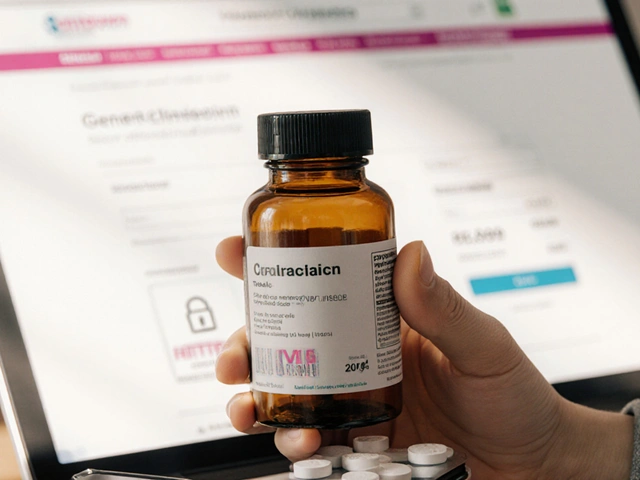Beta-Blocker Comparison Tool
This interactive tool compares Lopressor (metoprolol) with seven commonly prescribed alternatives. Use it to explore key features, benefits, and considerations for each medication.
Lopressor
Metoprolol
Cardio-selective beta-blocker
Post-MI protectionAtenolol
Cardio-selective beta-blocker
Once-daily dosingCarvedilol
Beta-blocker + Alpha-1 blocker
VasodilationPropranolol
Non-selective beta-blocker
Migraine prophylaxisBisoprolol
Cardio-selective beta-blocker
Minimal lung impactNebivolol
Cardio-selective + NO donor
Endothelial functionLabetalol
Beta- and Alpha-blocker
Pregnancy-safeSotalol
Beta-blocker + Class III anti-arrhythmic
Arrhythmia controlDetailed Comparison Table
| Drug | Class | Typical Oral Dose | Key Benefits | Common Side Effects | Best For |
|---|---|---|---|---|---|
| Lopressor (Metoprolol) | Beta-1 selective | 50-200 mg daily (split) | Strong evidence for post-MI protection | Fatigue, bradycardia, cold hands | Hypertension, angina, heart-failure |
| Atenolol | Beta-1 selective | 25-100 mg daily | Once-daily dosing, low CNS penetration | Fatigue, insomnia (rare) | Patients preferring simple regimen |
| Carvedilol | Beta-blocker + Alpha-1 blocker | 6.25-25 mg twice daily | Vasodilation adds extra blood-pressure drop | Dizziness, weight gain | Heart-failure with reduced ejection fraction |
| Propranolol | Non-selective beta-blocker | 10-40 mg three times daily | Effective for migraines, tremor | Bronchospasm, depression | Patients needing migraine prophylaxis |
| Bisoprolol | Beta-1 selective | 2.5-10 mg daily | High cardio-selectivity, minimal lung impact | Constipation, mild fatigue | Chronic angina, hypertension |
| Nebivolol | Beta-1 selective + NO donor | 5-10 mg daily | Improves endothelial function | Headache, occasional flushing | Patients concerned about metabolic side effects |
| Labetalol | Beta- and Alpha-blocker | 100-400 mg twice daily | Useful in pregnancy-related hypertension | Liver enzyme elevation, dizziness | Pregnant women, acute hypertensive emergencies |
| Sotalol | Beta-blocker + Class III anti-arrhythmic | 80-160 mg twice daily | Controls ventricular arrhythmias | Pro-arrhythmic QT prolongation | Patients with rhythm disorders needing beta-blockade |
Best For Specific Conditions
- Blood-pressure control only: A cardio-selective agent like atenolol or bisoprolol
- Heart-failure with reduced ejection fraction: Carvedilol or bisoprolol
- Pregnancy-related hypertension: Labetalol
- Migraines or essential tremor: Propranolol
- Metabolic concerns: Nebivolol
Important Considerations
- Avoid non-selective blockers (like propranolol) if you have asthma
- Consider bisoprolol if on CYP2D6 inhibitors like fluoxetine
- Generic versions can be more affordable than brand-name metoprolol
- Never stop abruptly - taper under medical supervision
- Monitor for rebound symptoms when changing medications
Note: Always consult with your healthcare provider before making any changes to your medication regimen. This information is for educational purposes only.
If you’ve been prescribed Lopressor and wonder whether another medication might fit you better, you’re not alone. Many people switch or consider switching because of side effects, specific health conditions, or simply cost. This guide walks you through what Lopressor is, when you might look for a substitute, and how the most popular alternatives stack up.
Key Takeaways
- Lopressor (metoprolol) is a cardio‑selective beta‑blocker used for hypertension, angina, and heart‑failure management.
- Typical reasons to consider an alternative include asthma, severe peripheral‑vascular disease, or stubborn fatigue.
- Seven widely used substitutes - atenolol, carvedilol, propranolol, bisoprolol, nebivolol, labetalol, and sotalol - cover a range of cardio‑selectivity, additional alpha‑blocking, and anti‑arrhythmic properties.
- Choosing the right drug hinges on your primary condition, co‑existing illnesses, dosing convenience, and side‑effect profile.
- Always discuss any change with a healthcare professional; abrupt stops can trigger rebound heart‑rate spikes.
What Is Lopressor (Metoprolol)?
Metoprolol is a beta‑1 selective blocker that reduces heart rate, contractility, and blood pressure. Its brand name Lopressor was launched in the early 1990s and quickly became a go‑to for hypertension and post‑myocardial‑infarction care.
Typical oral doses range from 25mg twice daily for angina to 100mg once daily for hypertension. The drug is well absorbed, metabolized by the liver, and mainly excreted via the kidneys.
How Metoprolol Works and Who Benefits Most
Metoprolol blocks beta‑1 receptors in the heart, slowing the electrical signals that tell the heart to beat. The net effect is lower cardiac output and reduced oxygen demand, which helps prevent chest pain and lowers blood pressure. People with stable angina, high blood pressure, or a recent heart attack typically see the biggest benefit.
When You Might Need an Alternative
Even though many tolerate Metoprolol well, certain situations call for a switch:
- Respiratory issues: Asthma or chronic obstructive pulmonary disease (COPD) can be aggravated by beta‑blockers, especially non‑selective types.
- Peripheral vascular disease: Reduced blood flow to the limbs may worsen with beta‑1 blockade.
- Severe fatigue or depression: Some patients report low energy or mood changes.
- Drug interactions: Metoprolol interacts with CYP2D6 inhibitors like fluoxetine, potentially raising blood levels.
- Cost or formulary restrictions: Generic options or insurance coverage may favor other names.
In those cases, a clinician might consider another beta‑blocker or a drug with a slightly different action profile.
Top Alternatives - Quick Snapshot
Below is a brief look at seven common substitutes. Each entry includes microdata for the first mention.
Atenolol is a cardio‑selective beta‑blocker similar to metoprolol but with a longer half‑life, allowing once‑daily dosing.
Carvedilol combines beta‑blockade with alpha‑1 antagonism, giving extra vasodilation useful in heart‑failure patients.
Propranolol is a non‑selective beta‑blocker often used for migraines and essential tremor, but it can affect bronchial muscles.
Bisoprolol offers high cardio‑selectivity and is favored for chronic stable angina and hypertension.
Nebivolol adds nitric‑oxide‑mediated vasodilation, which may improve metabolic profiles.
Labetalol blocks both beta and alpha receptors, making it a good choice during pregnancy‑related hypertension.
Sotalol is a class III anti‑arrhythmic with beta‑blocking effects, useful for certain rhythm disorders.
Side‑Effect Profiles - What to Expect
All beta‑blockers share some common side effects: slowed heart rate, cold extremities, and occasional dizziness. However, each drug brings its own nuances.
- Atenolol: Often causes mild fatigue but is less likely to cross the blood‑brain barrier, reducing sleep disturbances.
- Carvedilol: May cause orthostatic hypotension because of its alpha‑blocking action.
- Propranolol: Can trigger bronchospasm in asthmatics and may worsen depression.
- Bisoprolol: Generally well‑tolerated; occasional constipation reported.
- Nebivolol: Lower incidence of sexual dysfunction compared with traditional blockers.
- Labetalol: Can cause hepatotoxicity at high doses; monitor liver enzymes.
- Sotalol: Requires ECG monitoring due to pro‑arrhythmic risk in high doses.
Head‑to‑Head Comparison Table
| Drug | Class | Typical Oral Dose | Key Benefits | Common Side Effects | Best For |
|---|---|---|---|---|---|
| Lopressor (Metoprolol) | Beta‑1 selective | 50‑200mg daily (split) | Strong evidence for post‑MI protection | Fatigue, bradycardia, cold hands | Hypertension, angina, heart‑failure |
| Atenolol | Beta‑1 selective | 25‑100mg daily | Once‑daily dosing, low CNS penetration | Fatigue, insomnia (rare) | Patients preferring simple regimen |
| Carvedilol | Beta‑blocker + Alpha‑1 blocker | 6.25‑25mg twice daily | Vasodilation adds extra blood‑pressure drop | Dizziness, weight gain | Heart‑failure with reduced ejection fraction |
| Propranolol | Non‑selective beta‑blocker | 10‑40mg three times daily | Effective for migraines, tremor | Bronchospasm, depression | Patients needing migraine prophylaxis |
| Bisoprolol | Beta‑1 selective | 2.5‑10mg daily | High cardio‑selectivity, minimal lung impact | Constipation, mild fatigue | Chronic angina, hypertension |
| Nebivolol | Beta‑1 selective + NO donor | 5‑10mg daily | Improves endothelial function | Headache, occasional flushing | Patients concerned about metabolic side effects |
| Labetalol | Beta‑ and Alpha‑blocker | 100‑400mg twice daily | Useful in pregnancy‑related hypertension | Liver enzyme elevation, dizziness | Pregnant women, acute hypertensive emergencies |
| Sotalol | Beta‑blocker + Class III anti‑arrhythmic | 80‑160mg twice daily | Controls ventricular arrhythmias | Pro‑arrhythmic QT prolongation | Patients with rhythm disorders needing beta‑blockade |
How to Choose the Right Option
Start with your primary health goal:
- Blood‑pressure control only: A cardio‑selective agent like atenolol or bisoprolol works well.
- Heart‑failure with reduced ejection fraction: Carvedilol or bisoprolol have strong trial data.
- Pregnancy‑related hypertension: Labetalol is the safest beta‑blocker choice.
- Migraines or essential tremor: Propranolol remains the gold standard.
- Metabolic concerns (diabetes, cholesterol): Nebivolol’s nitric‑oxide effect may be advantageous.
Next, weigh any comorbid conditions. If you have asthma, steer clear of non‑selective blockers like propranolol. If you’re on antidepressants that inhibit CYP2D6, consider bisoprolol (which is less metabolized by that pathway).
Cost matters too. Generic versions of atenolol, bisoprolol, and propranolol are often cheaper than brand‑name metoprolol, especially if your insurance has a tiered formulary.

Practical Tips for Switching
- Never stop abruptly: Taper the dose over a week unless your doctor says otherwise.
- Monitor vitals: Check blood pressure and heart rate daily for the first two weeks after a change.
- Watch for rebound symptoms: Some patients feel palpitations or anxiety when beta‑blockers are reduced too quickly.
- Keep a side‑effect diary: Note any new fatigue, dizziness, or breathing changes and share them at follow‑up.
- Ask about labs: Certain drugs (labetalol, sotalol) may require liver or ECG monitoring.
Frequently Asked Questions
Frequently Asked Questions
Can I replace Lopressor with a cheaper generic?
Yes. Generic metoprolol tartrate is often less expensive than the brand name. If cost is the main driver, ask your pharmacist about the generic formulation before switching to another class.
Is Atenolol as effective as Metoprolol for heart‑failure?
Atenolol works well for hypertension and angina, but large heart‑failure trials used bisoprolol or carvedilol. If your doctor prescribed Metoprolol for heart‑failure, they may prefer staying within that evidence base.
Will a non‑selective beta‑blocker worsen my asthma?
Non‑selective blockers like propranolol can trigger bronchoconstriction, leading to asthma attacks. If you have any airway disease, stick with cardio‑selective options such as metoprolol, atenolol, or bisoprolol.
Is Nebivolol safe during pregnancy?
There isn’t enough safety data for Nebivolol in pregnancy, so doctors usually avoid it. Labetalol or labetalol‑based regimens are preferred for pregnant patients who need a beta‑blocker.
Do beta‑blockers affect blood sugar control?
Beta‑blockers can mask low‑blood‑sugar symptoms and slightly raise fasting glucose. If you have diabetes, a cardio‑selective drug at the lowest effective dose is usually safest.
Final Thoughts
The right beta‑blocker depends on your unique health picture. Lopressor remains a solid choice for many, but alternatives like atenolol, carvedilol, and nebivolol each bring distinct advantages. Use this guide to start a conversation with your clinician, and together you can pick a medication that balances effectiveness, tolerability, and cost.






17 Comments
Liam Davis
October 9, 2025 AT 14:39 PMMetoprolol, sold as Lopressor, is a cardio‑selective beta‑blocker that works by slowing the heart’s electrical conduction and reducing contractility; this translates to lower blood pressure and decreased oxygen demand for the myocardium. It is especially valuable after a myocardial infarction because large clinical trials have demonstrated a reduction in mortality and recurrent events. The usual dosing ranges from 50 mg to 200 mg per day, often split into two doses to maintain steadier plasma levels. One advantage of this split regimen is that it allows fine‑tuning based on blood pressure response and side‑effect profile. Common side effects include fatigue, cold extremities, and occasional bradycardia; patients should monitor their pulse regularly. Because metoprolol is metabolized by the CYP2D6 pathway, concurrent use of strong inhibitors such as fluoxetine may raise drug concentrations, necessitating dose adjustments. When considering a switch, physicians weigh factors like asthma or chronic obstructive pulmonary disease, since even cardio‑selective agents can cause bronchospasm at high doses. In patients with peripheral vascular disease, the reduced peripheral circulation from beta‑blockade can worsen claudication symptoms. Metoprolol’s impact on lipid profiles is neutral, making it a safe option for diabetic patients, though it may mask hypoglycemia symptoms. If cost is a concern, generic metoprolol tartrate is widely available and usually covered by insurance plans. For those experiencing significant fatigue, an alternative such as bisoprolol, which offers similar cardio‑selectivity with a longer half‑life, might be preferable. Conversely, patients needing additional vasodilation may benefit from carvedilol’s combined alpha‑blockade. It is crucial never to discontinue metoprolol abruptly; a gradual taper reduces the risk of rebound tachycardia and hypertension. Monitoring kidney function is also advised, especially in the elderly, because renal excretion becomes more prominent in later stages of life. Lifestyle modifications, including reduced sodium intake and regular aerobic exercise, complement the pharmacologic effects of any beta‑blocker. Discussing these nuances with your healthcare provider ensures the chosen therapy aligns with your personal health goals and comorbid conditions. 😊
Arlene January
October 12, 2025 AT 12:06 PMStick with the split dosing if you’re already seeing stable numbers, it’ll keep things predictable.
Kaitlyn Duran
October 15, 2025 AT 09:32 AMI’ve noticed that patients with mild asthma often tolerate low‑dose metoprolol without issues, especially when the dose stays under 50 mg daily; it seems the cardio‑selectivity helps limit bronchial effects. The key is coordinating with a pulmonologist to monitor lung function during any uptitration. Also, pairing the medication with a proper inhaler regimen can further safeguard against unexpected bronchospasm.
Terri DeLuca-MacMahon
October 18, 2025 AT 06:59 AMGreat point! 🎉 Keeping the pulmonologist in the loop creates a solid safety net, and the extra motivation of tracking your progress can turn a routine check‑up into a win‑win scenario. 🌟
gary kennemer
October 21, 2025 AT 04:26 AMWhen weighing Lopressor against its peers, it helps to frame the decision as a balance between hemodynamic goals and individual tolerability; the drug’s evidence base for post‑MI protection is solid, yet personal side‑effect profiles can tip the scale. For instance, if a patient’s primary concern is fatigue, a switch to bisoprolol could preserve cardio‑selectivity while offering a smoother daily rhythm due to its longer half‑life. Conversely, when vasodilation is desired-such as in heart‑failure with reduced ejection fraction-carvedilol’s alpha‑blockade adds a useful dimension. It is worth remembering that the cheapest option is not always the most cost‑effective in the long run; monitoring visits and lab work can shift the economic picture. Ultimately, a shared decision‑making process that respects the patient’s lifestyle, comorbidities, and values yields the most sustainable outcome.
Payton Haynes
October 24, 2025 AT 01:52 AMThere’s a hidden agenda behind the push for generic metoprolol; big pharma often disguises its profit‑driven motives behind “cost‑saving” campaigns, while the real risk is that low‑cost tablets may contain inconsistent bioavailability, leading to unpredictable blood‑pressure control. This variability can silently increase the chance of rebound hypertension, especially if patients unknowingly switch brands without proper medical oversight.
Earlene Kalman
October 26, 2025 AT 23:19 PMThat’s a stretch; most generics meet FDA standards and the bioequivalence data are publicly available.
Brian Skehan
October 29, 2025 AT 20:46 PMSure, the “studies” they cite are probably funded by the same companies that own the patents, so take the hype with a grain of salt.
Andrew J. Zak
November 1, 2025 AT 18:12 PMIt’s important to look at the bigger picture: beta‑blockers like Lopressor have been used worldwide for decades, and many clinicians across different health systems have shared best practices that can guide us in tailoring therapy to each individual’s cultural and lifestyle context.
Dominique Watson
November 4, 2025 AT 15:39 PMFrom a national perspective, it is essential that our prescribing guidelines prioritize evidence‑based therapies that have demonstrated efficacy within our own healthcare infrastructure, thereby ensuring that resources are allocated to treatments that best serve our citizens.
James Waltrip
November 7, 2025 AT 13:06 PMOne must not be deceived by the pedestrian façade of a simple beta‑blocker comparison; the pharmacodynamic intricacies of metoprolol versus its rivals unfold like a symphony of molecular choreography, each note resonating with distinct hemodynamic reverberations. The aristocracy of cardiovascular therapeutics, if you will, places metoprolol on a gilded pedestal for its post‑myocardial infarction laurels, yet the undercurrents of metabolic side‑effects whisper of a hidden dichotomy. Carvedilol, with its alpha‑blocking overture, conducts a vasodilatory crescendo that can be both blessing and bane depending on the patient’s baseline vascular tone. Meanwhile, the non‑selective troubadour propranolol sings a haunting ballad for migraine sufferers, albeit at the peril of bronchial obstruction in the asthmatic cohort. Nebivolol, the avant‑garde of nitric‑oxide donors, flirts with endothelial restoration, a novelty that may tantalize the metabolically inclined. The sagacious clinician must parse these melodious variances with a discerning ear, lest the orchestra descend into cacophony.
Chinwendu Managwu
November 10, 2025 AT 10:32 AMI love the poetic spin, but let’s not forget that most patients just want a pill that keeps their blood pressure down without a side‑effect parade; sometimes the simplest drug wins the day. 😊
Kevin Napier
November 13, 2025 AT 07:59 AMRemember, the best approach is to sit down with your doctor, lay out your daily routine, and pick the beta‑blocker that fits like a glove-whether that’s the once‑daily convenience of atenolol or the metabolic friendliness of nebivolol.
Sherine Mary
November 16, 2025 AT 05:26 AMEveryone seems to miss the fact that beta‑blockers globally suppress the sympathetic surge, which in turn blunts the natural stress response that our bodies rely on for acute challenges; this is why chronic use can lead to a subtle, insidious dampening of resilience. Moreover, the literature consistently shows that abrupt discontinuation triggers a rebound tachycardia that is not just a minor inconvenience but a genuine cardiovascular hazard. The silent impact on glucose metabolism, especially in diabetic patients, is often under‑reported, yet it can precipitate unnoticed hypoglycemic episodes. In my experience reviewing countless case files, the ones that falter are those where the prescriber failed to account for these cascading effects.
Monika Kosa
November 19, 2025 AT 02:52 AMWow, that’s a deep dive! I’ve heard whispers that some of those “case files” are actually curated to hide the full extent of beta‑blocker fallout-maybe the industry doesn’t want the public to see the whole picture. 😉
Gail Hooks
November 22, 2025 AT 00:19 AMIn the grand tapestry of cardiovascular care, each medication is but a thread, weaving together patient history, genetic predisposition, and the subtle art of lifestyle harmony. 🌿
Derek Dodge
November 24, 2025 AT 21:46 PMi was just looking at the table and it’s kinda cool how each drug has its own niche... honestly, sometimes i just go with whatever the doc says.